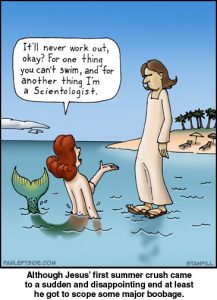Testimony about what someone claims to have heard from an eyewitness would not stand up in a court of law today — it is what is known as “hearsay”. Nevertheless, sometimes hearsay is all a historian has, and the rules of historical investigation are not as strict as those of the American legal system. We can utilize any sources available, and the only consequence will be that our conclusions about what happened will be less certain than if we had first-hand accounts written by the eyewitnesses themselves. (James McGrath in The Burial of Jesus: History & Faith, pp. 37-38)
This is an astonishing admission from an associate professor who presents himself as an historian. It is the sort of admission that one would never expect to hear anywhere except in the cloisters of BIBLICAL history!
Let’s work backwards through this. In McGrath’s’ last sentence he implies that first-hand accounts in and of themselves bring with them, by definition, a certain degree of credibility. The only question is one of degree.
Well of course that must necessarily be so, IF such a first-hand account testifies to something for which we have independent evidence. To show the nonsense of the fundamental logic of this proposition: If eyewitness A accosts me and informs me in his own words, even backed up by a stamped affidavit, that he has just seen a pixie step out from a mushroom and board a flying saucer that zapped him to Mars, . . . . Or what of someone who reported he was eyewitness to a man talking with the devil, who walked on water, who rose from the dead and changed his life from one of fear to one of courage . . . .
I don’t think I have to go any further to demonstrate the logical fallacy here. Damn humanists! They are the ones who we must hold responsible for shunting logic out and away from being a basic requirement for anyone aspiring to be a scholar nowadays.
Then we come to “sometimes hearsay is all a historian has”.
So. At least we have refreshing honesty at work here. What this biblical professor of history means that we have a Gospel. AND that Gospel is a hearsay report. We are not told who the reporters were. Nor are we even told who those to whom they reported were. And yep, we are not even told who is telling us who told the story that was heard hearsay from the reporters! Assuming there WERE any reporters to begin with. It is just as logical to suspect that our reporter is making it all up, and the antecedent reporters are all in our own imaginations and assumptions.
I once referenced a historian who is very famous but who also happens to have sympathies with those evil Reds, the Commies who still lurk just south of Florida plotting incessantly to undermine all godly righteous values. This historian, Eric Hobsbawm, had the devious trickery to admit to a professional error of method in a book he had written. He had written a history of Latin American bandits, but had been challenged over the naive way he swallowed certain testimonies as real evidence — even eyewitness or firsthand reports!
Richard W. Slatta quotes Eric Hobsbawm’s statement (in Bandits) stressing the need for external controls before deciding if a given narrative has any historical basis:
In no case can we infer the reality of any specific ‘social bandit’ merely from the ‘myth’ that has grown up around him. In all cases we need independent evidence of his actions. (p.142)
From p.24 of A Contra Corriente: a Journal on Social History and Literature in Latin America (2004)
Slatta himself adds:
Researchers inclined to take folk tales at face value would do well to consider John Chasteen’s conclusion about the creation of caudillo mythology on the Brazilian-Uruguayan border. “Borderlanders collected, refashioned, or even invented outright memorable words of their political protagonists. . . . borderland Federalists constructed an image of the hero they wanted.”
Many scholars have found popular and literary sources, folklore, and first-hand reports by “just plain folks,” to be fraught with difficulties. (p.25)
Here is how McGrath responds to this sinister communist methodology that is surely manufactured expressly to undermine faith in the Gospels as history:
Second, it seems that your quote from Hobsbawm indicates once again that, unless you have some sort of evidence other than texts, you are unwilling to entertain the possibility that a text bears some relationship to historical events. You (and Hobsbawm) are free to adopt this approach, of course, but might Hobsbawm’s desire to rewrite the legacy of Communism suggest that his statement has more to do with ideology than mainstream historiography?
First, note how this honest professor works intellectual sleight of hand by changing the notion of “independent evidence” to “evidence other than texts”. (Hobsbawm and Slatta would have loved to have had primary textual evidence that they could evaluate with a view to testing the historicity of the narratives they heard.)
Second, it is hard not to note the good professor’s linking of Hobsbawm with a presumed “desire to rewrite the legacy of Communism”! Where that came from I do not know. So rather than address the methodology in question, this associate professor opts, rather, to point to his own gratuitous speculations about the political views of the renowned historian.
A leftist historian publicly confesses he was at methodological fault for relying on hearsay, and a biblical historian who needs to rely on hearsay to make his faith-based case responds by questioning the leftist’s politics!
So let me repeat my challenge to the historical-Jesus historian of faith: Continue reading “Biblical historian McGrath admits to relying on hearsay and uncorroborated reports”
Like this:
Like Loading...



 R. Joseph Hoffmann has in interesting introduction to his (re)publication of
R. Joseph Hoffmann has in interesting introduction to his (re)publication of 
 The following are the arguments for the historicity of Jesus. I have taken them from Dr James McGrath’s various comments to posts on this blog, and they are essentially direct quotations of his words. I want to be clear that none of my engagements with the methodology of historical Jesus scholars misrepresents any of the following arguments.
The following are the arguments for the historicity of Jesus. I have taken them from Dr James McGrath’s various comments to posts on this blog, and they are essentially direct quotations of his words. I want to be clear that none of my engagements with the methodology of historical Jesus scholars misrepresents any of the following arguments.

 Niels Peter Lemche has a chapter in Lester Grabbe’s
Niels Peter Lemche has a chapter in Lester Grabbe’s 